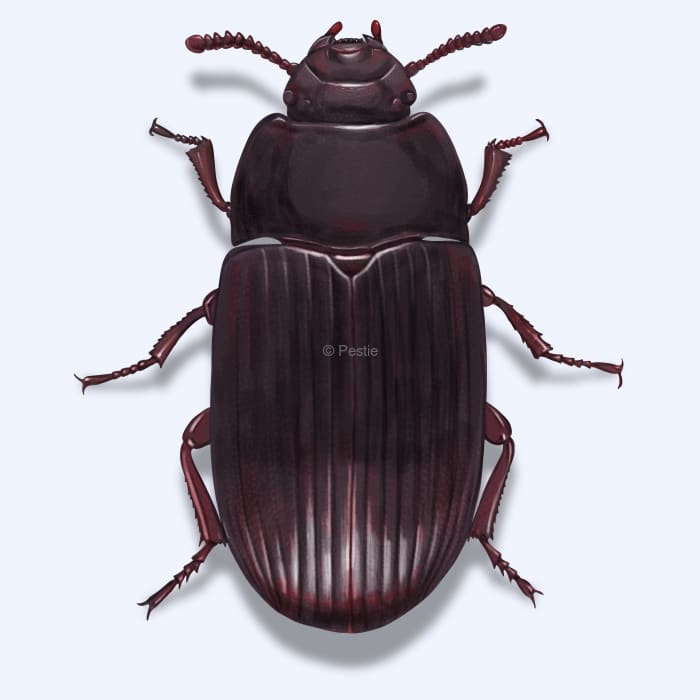How to identify and get rid of litter beetles

Litter critters: keeping unwanted beetles away
Litter beetles aren't your typical household pests unless you live with a bunch of chickens. Also known as the lesser mealworm, litter beetles love to burrow into poultry litter and can be abundant in commercial poultry houses or your backyard chicken coup.
As a homeowner, you're less likely to encounter these beetles, but they can be found in certain areas of your property. While litter beetles are primarily outdoor pests, their presence can indicate an excess of decaying material or poor sanitation around your property, which could attract other unwanted pests or lead to unsanitary conditions.
Litter beetles are mostly associated with decomposition. Females lay their eggs in moist, organic material where the larvae can immediately access food upon hatching. These larvae, or grubs, are voracious eaters, consuming decaying leaves, wood, and other organic matter, which helps break it all down into soil. So, they're the good guys, right?
Well, this can also be a problem when they invade areas intended for composting or when they inadvertently enter our homes. Managing their population is crucial, not only to maintain the aesthetics and health of your yard but also to prevent them from attracting other predators, like spiders, scorpions, or centipedes. Understanding their behavior and needs is the first step in keeping their numbers in check and ensuring they stay where they are supposed to be.
How to identify litter beetles
Litter beetles are dark brown to black with an oval body shape. If you have magnification, you'll see small puncture holes or pits all over their exoskeleton or outer shell. Additionally, you can look for long groves that run down their wing covers, also known as elytra.
If you see these beetles frequently around decomposing plant material in your yard or near garbage storage areas, you're likely dealing with a litter beetle infestation. Indicators of their presence include increased beetle activity around pet waste or compost piles and the sight of these beetles on the walls or floors near these areas.
How big are litter beetles?
Litter beetles are about 1/4 to 1/2 inch long.
What other pest looks like a litter beetle?
Litter beetles look like small ground beetles or any other common black beetle.
Where do litter beetles live?
These beetles are found throughout the United States, thriving in environments where they can find organic waste and decaying material. They are occasionally found indoors, especially in areas like basements and garages where they might wander in from the garden. Also, they are commonly found in compost piles, under decaying logs, leaf litter, and other areas rich in organic waste.
How to get rid of litter beetles
If you find a lot of litter beetles in your home or yard, then that usually means you have decomposing organic matter too close to your home. You should regularly clean and remove animal waste from your yard and get rid of any decaying organic material near the house.
If you are making compost, make sure to keep it covered or turn it regularly.
To keep litter beetles out of your home, try these tips:
- Exclusion: Seal cracks and crevices around the home to prevent beetles from entering.
- Physical removal: Regularly inspect and physically remove any beetles from areas that are not wanted.
- Pestie Smart Pest Plan: Consider establishing a bug barrier around your home. Pestie offers a DIY spray with the same ingredients the pros use, but that only takes you 10 minutes to spray around your home.
Treat litter beetles with Pestie
If you're still having trouble keeping litter beetles away, the best option is to use a pro-grade, effective pest control solution like Pestie.
Pestie is a do-it-yourself pest control solution that's specially designed to keep litter beetles and other pests away from your home.
With Pestie, you can rest easy knowing that your living space is protected and free of creepy crawlies. And the best part? It's designed for people, pets, and the planet, so you can say goodbye to harsh chemicals and hello to peace of mind!
- Save hundreds compared to traditional annual pest plans
- People, pet, and planet-friendly
- Pro-grade customized formulas
Quick facts
- Scientific name
Alphitobius Diaperinus
- Other common names
Darkling Beetles, Black Beetles
- Colors
Shiny black
- Life span
1 year
- Diet
Organic matter
How dangerous are Litter Beetles?
Low danger risk
Litter beetles do not pose a direct threat to human health.
Litter beetles can become a big problem in commercial poultry houses. They are known to spread over 30 different bird diseases. However, some companies are using the mealworms to grow into commercial feed for poultry.








